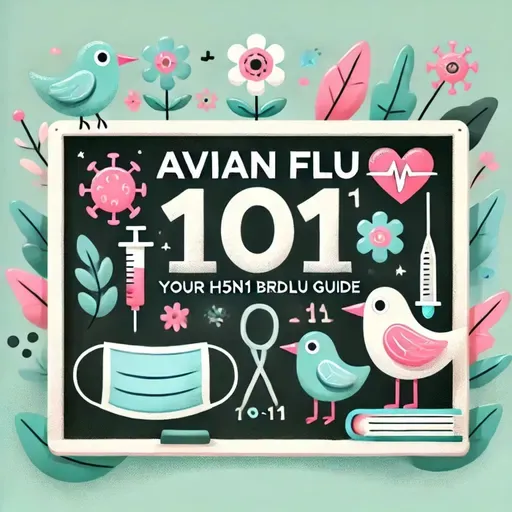
17 October 2025
H5N1 Bird Flu Explained: What You Need to Know About Transmission, Risk, and Prevention Strategies
Avian Flu 101: Your H5N1 Bird Flu Guide
About
**Avian Flu 101: Your H5N1 Bird Flu Guide**
Hello and welcome to "Avian Flu 101." Today, we'll explore the basics of H5N1 bird flu, its history, transmission, and how it compares to seasonal flu and COVID-19. Let's start with the basics.
Avian flu, or bird flu, is a viral infection that primarily affects birds. Currently, the H5N1 strain is of concern due to its high pathogenicity, meaning it can quickly infect and kill poultry within 48 hours.
Historically, bird flu was first identified in 1996 and has since spread globally. While it can infect humans, most cases have been mild and have occurred in farm workers.
The bird-to-human transmission process can be thought of like a doorway. When birds carry the virus, it's like they're holding a key. If you touch something contaminated by the bird's saliva or feces and then touch your face, you're unlocking the door to infection. This is why avoiding contact with sick or dead birds is crucial.
Bird flu is distinct from seasonal flu and COVID-19. Unlike seasonal flu, bird flu is highly pathogenic in birds but not necessarily in humans. COVID-19, caused by the SARS-CoV-2 virus, has a wider range of symptoms and transmits more easily between people.
Now, let's answer some common questions:
Q: Is bird flu a significant threat to humans?
A: Currently, the risk is low, but the virus could mutate to become more contagious.
Q: Can I get vaccinated against bird flu?
A: Vaccines are available for high-risk individuals but are not widely accessible.
Q: How can I protect myself?
A: Avoid touching sick birds, cook poultry thoroughly, and practice good hygiene.
Thank you for tuning in. Join us next week for more insights. This has been a Quiet Please production. For more, check out QuietPlease.ai.
For more http://www.quietplease.ai
Get the best deals https://amzn.to/3ODvOta
This content was created in partnership and with the help of Artificial Intelligence AI
Hello and welcome to "Avian Flu 101." Today, we'll explore the basics of H5N1 bird flu, its history, transmission, and how it compares to seasonal flu and COVID-19. Let's start with the basics.
Avian flu, or bird flu, is a viral infection that primarily affects birds. Currently, the H5N1 strain is of concern due to its high pathogenicity, meaning it can quickly infect and kill poultry within 48 hours.
Historically, bird flu was first identified in 1996 and has since spread globally. While it can infect humans, most cases have been mild and have occurred in farm workers.
The bird-to-human transmission process can be thought of like a doorway. When birds carry the virus, it's like they're holding a key. If you touch something contaminated by the bird's saliva or feces and then touch your face, you're unlocking the door to infection. This is why avoiding contact with sick or dead birds is crucial.
Bird flu is distinct from seasonal flu and COVID-19. Unlike seasonal flu, bird flu is highly pathogenic in birds but not necessarily in humans. COVID-19, caused by the SARS-CoV-2 virus, has a wider range of symptoms and transmits more easily between people.
Now, let's answer some common questions:
Q: Is bird flu a significant threat to humans?
A: Currently, the risk is low, but the virus could mutate to become more contagious.
Q: Can I get vaccinated against bird flu?
A: Vaccines are available for high-risk individuals but are not widely accessible.
Q: How can I protect myself?
A: Avoid touching sick birds, cook poultry thoroughly, and practice good hygiene.
Thank you for tuning in. Join us next week for more insights. This has been a Quiet Please production. For more, check out QuietPlease.ai.
For more http://www.quietplease.ai
Get the best deals https://amzn.to/3ODvOta
This content was created in partnership and with the help of Artificial Intelligence AI